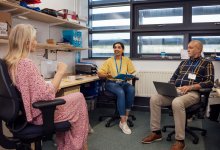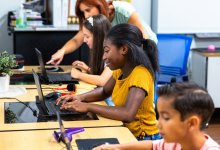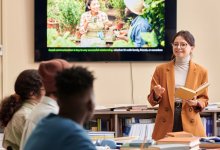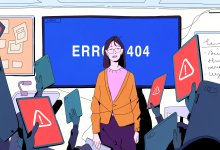- Interest-Based Learning
Integrating Spontaneous Learning Into Pre-K Curriculum
Teachers can use moments when children express curiosity as entry points to foster deep learning within planned lessons.Your content has been saved!
Go to My Saved Content. - Curriculum Planning
Reimagining PLCs as Instructional Impact Teams
Repurposing traditional professional learning communities as teacher-led teams builds trust and strengthens instructional alignment.Your content has been saved!
Go to My Saved Content. - Student Engagement
Philosophical Chairs Brings Out the Passion in ELA Classrooms
This low-prep, high-engagement activity prompts students to debate a question and critically examine their own and opposing positions.Your content has been saved!
Go to My Saved Content. - Research
A Simple Recipe for Blissed-Out Kids
A 2025 study showed that more recess time means less stress for students, suggesting that play is not just a nice-to-have—it’s essential for children’s well-being.Your content has been saved!
Go to My Saved Content. - Assessment
How to Develop Test-Ready Students
There’s a difference between teaching to the test and developing test-specific thinking that will help students effectively apply what they’ve learned all year. - Teaching Strategies
Using Secondary Sources in High School History
Teachers can use differing interpretations of historical events to help students move from memorizing events to analyzing and interpreting them.246Your content has been saved!
Go to My Saved Content. - Technology Integration
Using Text-to-Speech Technology to Support All Students
Built-in screen readers improve the accessibility of texts and can help students achieve success in building higher-level literacy skills.324Your content has been saved!
Go to My Saved Content. - Administration & Leadership
Strengthening Students’ Foundational Math Skills in Middle School
If many students are struggling with operations like dividing decimals, this schoolwide approach to scheduling can help.1.3kYour content has been saved!
Go to My Saved Content. - Classroom Management
How to Create a Values-Aligned Classroom
Teachers can collaborate with students to identify shared values that establish a foundation of respect and a positive learning environment.435Your content has been saved!
Go to My Saved Content. - Social & Emotional Learning (SEL)
Modeling Calm for Preschool Students
Teachers can focus on promoting a sense of emotional safety to help students develop self-regulation and resilience.641Your content has been saved!
Go to My Saved Content.
Popular
- Research
The 10 Most Significant Education Studies of 2025
We’re back with our roundup of the most insightful studies of the year, from the power of brain breaks to groundbreaking research on AI, cell phones, and handwriting in the classroom. - Student Engagement
5 Ways to Encourage Deep Mathematical Thinking
You can adapt the curriculum you have to create rich tasks that invite reasoning and build students’ problem-solving skills.36.3kYour content has been saved!
Go to My Saved Content. - Technology Integration
3 Simple Slide Tips That Deepen Learning—and Save Time
Whether you use Google Slides or something else, you can promote deep thinking during presentations by tweaking the slides you already have.16.2kYour content has been saved!
Go to My Saved Content. - Technology Integration
5 Tech Integration Mistakes—and What to Do Differently Next Time
Classroom tech use will always involve some element of trial and error, but many pitfalls are avoidable when you know what to watch out for.13.5kYour content has been saved!
Go to My Saved Content. - Media Literacy
5 Ways to Build Critical Literacy in the Age of AI
With so much information—and misinformation—coming at them every day, students need to learn how to verify truth.
- ChatGPT & Generative AI
AI Isn’t the Main Problem—It Just Shows Us What That Problem Is
Students are chasing points and grades because that’s what the education system prioritizes, but we can guide them to focus on learning. - Assessment
Empowering Students Through a Focus on Incremental Progress
Elementary teachers can help students feel confident tackling big goals by encouraging them to focus on getting a little bit better every day.4.8kYour content has been saved!
Go to My Saved Content. - Assessment
Translating Standards Into Student-Friendly Terms
Designing an effective assessment requires first deconstructing the standards into clear criteria of success that students can understand.7.1kYour content has been saved!
Go to My Saved Content. - Assessment
8 Creative Performance Tasks for World Language Classes
Try these ideas to move from vocabulary quizzes to activities where students communicate in real-world situations.12.6kYour content has been saved!
Go to My Saved Content. - Assessment
Solidifying Core Concepts With Examples and Non-Examples
Asking students to identify an example of what something is—and importantly, what it isn’t—helps establish clarity and leaves little room for misconception.Your content has been saved!
Go to My Saved Content.
- Brain-Based Learning
5 Ways to Help Students Reset Their Thinking
When students hit cognitive roadblocks, these strategies will help them pause, rethink their approach, and reengage with their learning process.Your content has been saved!
Go to My Saved Content. - Student Engagement
Simple Swaps for Moving From Passive to Active Learning
These tips demonstrate that planning for active learning experiences doesn’t have to be time-intensive or difficult.2.4kYour content has been saved!
Go to My Saved Content. - Game-Based Learning
Using Choice Boxes to Enhance Student Engagement
Providing upper elementary students with choices can help teachers differentiate through learning experiences that feel fun. - Classroom Management
60-Second Strategy: Board Splash
This quick and easy warm-up primes students to think creatively and gets them in the mindset for class.Your content has been saved!
Go to My Saved Content. - Student Engagement
5 Ways to Overcome the Preschool Engagement Lull
Even young students may get tired of school, and introducing movement breaks or reorganizing the classroom can help them get back on track.1.8kYour content has been saved!
Go to My Saved Content.
- Trauma-Informed Practices
Practical Ways to Support Students With Adverse Childhood Experiences
For children who have experienced trauma, trusting adults and navigating the classroom may be difficult, but there are simple ways to help them feel safe and supported.1.6kYour content has been saved!
Go to My Saved Content. - Mindfulness
Creating Moments of Calm in the Weeks Before Winter Break
When engagement wanes before a long vacation, teachers can introduce mindful breaks to help students reset and refocus.7.9kYour content has been saved!
Go to My Saved Content. - Social & Emotional Learning (SEL)
Reinforcing SEL in Physical Education Classes
PE teachers can foster students’ social and emotional learning by using consistent routines and modeling a focus on mindful breathing.2.6kYour content has been saved!
Go to My Saved Content. - Student Engagement
Beyond Your Classroom Walls
Taking lessons outside can not only boost engagement but also help students find meaningful connections to the world around them.1.4kYour content has been saved!
Go to My Saved Content. - ChatGPT & Generative AI
Schools Try AI as Student Mental Health Needs Surge
Social and emotional, behavioral, and mental health needs are outpacing what schools can provide. Can technology—namely AI—step in to help?4.7kYour content has been saved!
Go to My Saved Content.





























